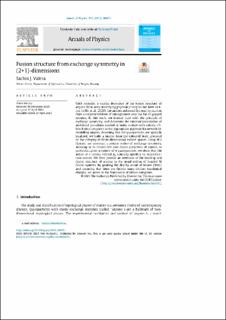| dc.contributor.author | Valera, Sachin Jayesh | |
| dc.date.accessioned | 2022-04-01T11:27:41Z | |
| dc.date.available | 2022-04-01T11:27:41Z | |
| dc.date.created | 2022-01-18T17:57:34Z | |
| dc.date.issued | 2021 | |
| dc.identifier.issn | 0003-4916 | |
| dc.identifier.uri | https://hdl.handle.net/11250/2989256 | |
| dc.description.abstract | Until recently, a careful derivation of the fusion structure of anyons from some underlying physical principles has been lacking. In Shi et al. (2020), the authors achieved this goal by starting from a conjectured form of entanglement area law for 2D gapped systems. In this work, we instead start with the principle of exchange symmetry, and determine the minimal prescription of additional postulates needed to make contact with unitary ribbon fusion categories as the appropriate algebraic framework for modelling anyons. Assuming that 2D quasiparticles are spatially localised, we build a functor from the coloured braid groupoid to the category of finite-dimensional Hilbert spaces. Using this functor, we construct a precise notion of exchange symmetry, allowing us to recover the core fusion properties of anyons. In particular, given a system of n quasiparticles, we show that the action of a certain n-braid βn uniquely specifies its superselection sectors. We then provide an overview of the braiding and fusion structure of anyons in the usual setting of braided 6j fusion systems. By positing the duality axiom of Kitaev (2006) and assuming that there are finitely many distinct topological charges, we arrive at the framework of ribbon categories. | en_US |
| dc.language.iso | eng | en_US |
| dc.publisher | Elsevier | en_US |
| dc.rights | Navngivelse 4.0 Internasjonal | * |
| dc.rights.uri | http://creativecommons.org/licenses/by/4.0/deed.no | * |
| dc.title | Fusion structure from exchange symmetry in (2+1)-dimensions | en_US |
| dc.type | Journal article | en_US |
| dc.type | Peer reviewed | en_US |
| dc.description.version | publishedVersion | en_US |
| dc.rights.holder | Copyright 2021 The Author(s) | en_US |
| dc.source.articlenumber | 168471 | en_US |
| cristin.ispublished | true | |
| cristin.fulltext | original | |
| cristin.qualitycode | 1 | |
| dc.identifier.doi | 10.1016/j.aop.2021.168471 | |
| dc.identifier.cristin | 1984050 | |
| dc.source.journal | Annals of Physics | en_US |
| dc.identifier.citation | Annals of Physics. 2021, 429, 168471. | en_US |
| dc.source.volume | 429 | en_US |

